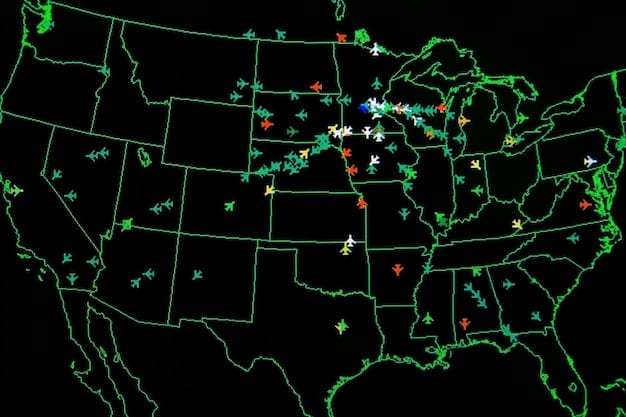US Supreme Court’s Cross-State Air Pollution Rule: Potential Consequences Explored

The US Supreme Court’s decision regarding the Cross-State Air Pollution Rule (CSAPR) carries significant potential consequences for air quality, public health, energy markets, and environmental regulatory frameworks across the United States.
The intricate web of environmental regulations in the United States is constantly evolving, with significant impacts stemming from judicial interpretations. Recently, a pivotal decision by the US Supreme Court regarding the Cross-State Air Pollution Rule (CSAPR) has brought renewed attention to how states manage air quality and interstate pollution. This ruling, while complex, holds the potential to reshape environmental policy, public health outcomes, and the energy landscape for years to come. Understanding its ramifications requires a deep dive into the nuances of the rule, the Court’s rationale, and the multifaceted implications for various stakeholders.
understanding the cross-state air pollution rule (csapr)
The Clean Air Act, a cornerstone of American environmental law, mandates that states take steps to reduce air pollution within their borders. However, air pollution does not respect state lines. Emissions from power plants and industrial facilities in one state can travel hundreds of miles, contributing to ozone and fine particulate matter (PM2.5) concentrations in downwind states, making it difficult for those states to meet national ambient air quality standards (NAAQS). This interstate transport of pollution has long been a contentious issue, leading to complex legal and regulatory challenges. The US Environmental Protection Agency (EPA) developed the Cross-State Air Pollution Rule (CSAPR) precisely to address this problem, aiming to reduce the interstate transport of harmful pollutants like sulfur dioxide (SO2) and nitrogen oxides (NOx) that contribute to smog and acid rain.
CSAPR established a cap-and-trade program for SO2 and NOx emissions from power plants in eastern and Midwestern states, requiring upwind states to reduce emissions that significantly contribute to downwind states’ nonattainment of air quality standards. Its goal was to ensure that states uphold their obligation under the Clean Air Act’s “good neighbor” provision. This provision requires states to prohibit any air pollutant emissions that “contribute significantly to nonattainment” or “interfere with maintenance” of NAAQS in any other state. The rule aimed to create an equitable system where the burden of reducing interstate pollution was shared among contributing states.
the genesis of csapr and its predecessors
CSAPR was not the EPA’s first attempt to tackle interstate air pollution. It evolved from earlier initiatives like the NOx SIP Call and the Clean Air Interstate Rule (CAIR). Each of these rules faced significant legal challenges, highlighting the inherent complexities of regulating emissions across state boundaries. CAIR, for instance, was initially vacated by a federal court but ultimately allowed to remain in effect while the EPA developed a replacement. These legal battles underscored the scientific and political difficulties in attributing pollution to specific upwind sources and allocating reduction responsibilities.
- NOx SIP Call (1998): Required 22 states and the District of Columbia to reduce NOx emissions to mitigate ozone transport.
- Clean Air Interstate Rule (CAIR) (2005): Replaced the NOx SIP Call, targeting SO2 and NOx emissions from power plants in 28 eastern states.
- CSAPR (2011): Developed as a direct response to legal challenges against CAIR, aiming for a more legally robust and effective framework for reducing interstate pollution.
The EPA’s development of CSAPR involved extensive scientific modeling to determine the contribution of upwind states to downwind air quality problems. This modeling helped establish emission budgets for affected states, creating a market-based mechanism for compliance. The allowances could be bought and sold, providing flexibility for companies to meet their emission reduction targets cost-effectively. Despite its technical sophistication and careful crafting, CSAPR, like its predecessors, faced immediate legal scrutiny from various states and industry groups, arguing over its scope, implementation, and perceived economic burdens. The ongoing legal saga illustrates the deep divisions and high stakes involved in national environmental regulation, where economic pressures often clash with public health and environmental imperatives.
Ultimately, CSAPR represents a critical tool in the EPA’s arsenal for achieving national air quality goals. Its effectiveness hinges on its ability to withstand legal challenges and ensure a fair and efficient reduction of interstate pollution. The Supreme Court’s involvement signifies the rule’s profound importance in defining the boundaries of federal environmental authority and state responsibilities in addressing a shared environmental challenge.
the supreme court’s role and recent decision
The United States Supreme Court plays a crucial role in interpreting federal laws, including environmental statutes like the Clean Air Act. Its decisions set precedents that guide lower courts and administrative agencies, fundamentally shaping the implementation of environmental policy. The Court’s involvement in the Cross-State Air Pollution Rule (CSAPR) stemmed from years of legal challenges brought by states and industry groups against the Environmental Protection Agency (EPA)’s various attempts to regulate interstate air pollution. The latest challenge focused on whether the EPA’s framework for implementing the “good neighbor” provision of the Clean Air Act was permissible.
Specifically, the dispute revolved around the EPA’s authority to impose federal implementation plans (FIPs) on states that failed to submit adequate state implementation plans (SIPs) to address their contributions to downwind pollution. Some states argued that the EPA overstepped its authority by dictating specific emission reductions and imposing a federal rather than state-led approach. They contended that the good neighbor provision should primarily allow states to determine how best to address shared pollution issues. The intricacies of the Court’s deliberations often involve balancing Congressional intent, agency expertise, state sovereignty, and practical environmental outcomes.
key arguments and legal precedents
The legal battles surrounding CSAPR and its predecessors have consistently highlighted fundamental questions about environmental federalism. States often argue for greater flexibility in meeting federal standards, while the EPA maintains that a consistent, national approach is necessary for addressing pervasive issues like interstate pollution. The Court considered various legal arguments, including whether the EPA’s interpretation of “significant contribution” align with the Clean Air Act’s statutory language and whether the rule imposed an undue burden on upwind states.
- Balance of Power: A recurring theme is the balance between federal regulatory authority and states’ rights in implementing environmental policy.
- Statutory Interpretation: How rigorously the Court interprets the “good neighbor” provision’s language is critical to the scope of EPA’s power.
- Economic Impact: Arguments often include the economic costs and benefits of compliance for industries and states.
The Supreme Court’s ruling on CSAPR did not overturn the rule entirely but, in a complex series of decisions over time, has shaped its application and the EPA’s regulatory approach. While the Court generally upheld the EPA’s core authority to issue a rule like CSAPR, it has occasionally sent specific aspects back to lower courts for reconsideration or clarified the parameters of EPA’s discretion. The latest major ruling broadly confirmed the EPA’s authority to require upwind states to address pollution transported across state lines. This affirmation is crucial for the EPA’s ability to enforce national air quality standards, particularly in addressing ambient ozone and fine particulate matter, which are linked to various public health issues. However, the exact specifics of how this authority can be exercised continue to be debated and clarified through subsequent litigation and regulatory action. The Supreme Court’s decisions, therefore, represent not an end to the story, but rather a significant chapter in an ongoing dialogue about environmental governance in the U.S.

impact on air quality and public health
The direct and immediate consequences of the Supreme Court’s decision on the Cross-State Air Pollution Rule (CSAPR) ripple through the environmental landscape, particularly affecting air quality and, by extension, public health. CSAPR was designed precisely to reduce the transport of pollutants like sulfur dioxide (SO2) and nitrogen oxides (NOx) that contribute to the formation of fine particulate matter (PM2.5) and ground-level ozone. These pollutants are well-documented contributors to a wide range of adverse health effects, including respiratory illnesses, cardiovascular disease, and premature death. Therefore, the effectiveness and enforcement of CSAPR directly correlate with improvements in the air breathed by millions of Americans.
When the rule is fully enforced and upheld, it leads to significant reductions in emissions from power plants, which are major sources of these pollutants. These reductions translate into clearer skies and healthier air in downwind states, often hundreds of miles from the original emission sources. The EPA estimates that successful implementation of CSAPR could lead to substantial public health benefits, including preventing thousands of premature deaths, hospitalizations, and cases of respiratory illness annually. For communities suffering from disproportionately high levels of air pollution, often those near industrial centers or downwind of major emission sources, the benefits are particularly acute. A strong CSAPR means a greater chance for these communities to experience tangible improvements in local air quality, leading to better overall health outcomes.
specific health outcomes linked to pollution reduction
The link between reduced air pollution and improved health is scientifically robust. Lower concentrations of PM2.5 can decrease the incidence of heart attacks, strokes, and exacerbations of asthma and chronic obstructive pulmonary disease (COPD). Similarly, reductions in ground-level ozone, a potent respiratory irritant, can alleviate symptoms for individuals with respiratory conditions and reduce the frequency of emergency room visits and hospital admissions. The public health benefits extend beyond individual illness, potentially reducing healthcare costs and improving productivity across affected regions.
- Reduced Respiratory Illnesses: Fewer cases of asthma attacks, bronchitis, and other breathing difficulties.
- Decreased Cardiovascular Disease: Lower rates of heart attacks, strokes, and related conditions.
- Prevention of Premature Deaths: A significant reduction in mortality attributed to air pollution exposure.
- Improved Productivity: Less sick leave and better overall population health contribute to economic well-being.
Conversely, any significant weakening or delay in the implementation of CSAPR could have detrimental effects. If the Supreme Court’s decision were to undermine the EPA’s ability to enforce emission reductions effectively, upwind states might face fewer immediate pressures to control their pollution. This could lead to a stagnation or even an increase in the transport of harmful pollutants, jeopardizing air quality gains in downwind regions. Such a scenario would inevitably result in higher rates of pollution-related illnesses, increased healthcare burdens, and a reversal of progress made under the Clean Air Act. The decision of the highest court therefore has profound implications, not just for legal precedents, but for the very breath taken by citizens across the nation, underscoring the critical role of environmental regulation in safeguarding public health.
economic repercussions and energy markets
The Supreme Court’s decision on the Cross-State Air Pollution Rule (CSAPR) carries significant economic implications, particularly for energy markets and industries reliant on fossil fuels. Environmental regulations, while designed to protect public health and the environment, inevitably impose costs on businesses that must comply with new emission standards. CSAPR’s cap-and-trade mechanism specifically targets power plants, compelling them to reduce emissions of sulfur dioxide (SO2) and nitrogen oxides (NOx). This can lead to various economic adjustments, including investments in pollution control technologies, shifts in fuel sources, and potential changes in electricity prices.
For power generators, compliance often means either installing scrubbers and other expensive control equipment, retiring older coal-fired plants, or switching to cleaner fuels like natural gas or renewable energy sources. These decisions have ripple effects throughout the energy sector. A strong, consistently enforced CSAPR can accelerate the transition away from high-emitting coal power, promoting the growth of cleaner energy alternatives. This shift can stimulate investment in renewable energy infrastructure and create jobs in the green technology sector. However, it also presents challenges for communities and industries historically dependent on coal mining and coal-fired power generation, potentially leading to job losses and economic displacement in those areas.
market dynamics and investment shifts
The market for emission allowances under CSAPR directly influences the operational costs of power plants. When allowances are scarcer or more expensive due to stringent emission caps, it incentivizes companies to reduce emissions more aggressively. This market signal can drive innovation in clean energy technologies and encourage utilities to consider more sustainable long-term energy strategies. Conversely, a weakening of the rule, or prolonged legal uncertainty, could damp down these investments, potentially leading to a slower transition to cleaner energy and prolonged reliance on higher-emitting power sources. The stability of the regulatory framework is crucial for long-term investment planning in the dynamic energy sector.
- Investment in Cleaner Technologies: Increased spending on pollution controls, renewable energy, and natural gas infrastructure.
- Shifts in Fuel Mix: Accelerated move away from coal towards natural gas, solar, and wind power.
- Electricity Price Impacts: Potential for short-term price increases due to compliance costs, offset by long-term stability and health benefits.
- Job Market Changes: Creation of jobs in renewable energy and pollution control, alongside potential job losses in traditional fossil fuel sectors.
The economic impact of CSAPR is not confined to the energy sector alone. Industries that rely heavily on energy, or those that are themselves significant sources of SO2 and NOx, may also face increased operational costs. However, these costs are often weighed against the economic benefits of improved public health, such as reduced healthcare expenditures and increased worker productivity. From a broader economic perspective, the decision reinforces the market’s trajectory towards cleaner energy, but the pace and distribution of this transition will heavily depend on the specific nuances of the Court’s ruling and future regulatory actions. Ultimately, the balance between environmental protection and economic growth continues to be a central tension that judicial decisions on rules like CSAPR directly influence.
implications for state autonomy and federal oversight
The Supreme Court’s decision on the Cross-State Air Pollution Rule (CSAPR) is not merely about air quality; it also profoundly impacts the delicate balance between state autonomy and federal oversight in environmental regulation. The Clean Air Act’s “good neighbor” provision is a key battleground in this ongoing tension, as it requires states to prevent their emissions from harming air quality in neighboring states. The Environmental Protection Agency (EPA), under its federal mandate, develops rules like CSAPR to ensure this provision is met, often stepping in with federal implementation plans (FIPs) when states fail to submit adequate state implementation plans (SIPs). The Court’s stance on these matters defines the extent to which the federal government can dictate environmental policy to states.
A ruling that broadly upholds the EPA’s authority in enforcing CSAPR strengthens federal oversight. It signals that states have a clear responsibility to manage their emissions in a way that respects the air quality goals of their neighbors, and that the EPA has the necessary tools to ensure compliance. This provides a more consistent, nationwide approach to tackling pollutants that cross state lines, preventing a patchwork of regulations that could undermine national air quality goals. Conversely, a ruling that significantly curbs the EPA’s power could grant states more leeway in their emission reduction strategies, but potentially at the cost of diminished air quality in downwind states, leading to more interstate disputes and legal challenges.
federal precedent and future regulatory landscape
The Court’s interpretation of federal authority in CSAPR sets an important precedent for future environmental regulations. If the EPA’s role in addressing interstate pollution is affirmed, it could embolden the agency to craft similar federal-level solutions for other transboundary environmental issues, such as water pollution or climate-altering emissions. This consistency could provide greater certainty for businesses and states, knowing that federal standards will underpin environmental compliance efforts. However, if the Court were to limit the EPA’s ability to impose stringent FIPs, it could lead to a wave of state-level litigation as downwind states pursue legal avenues to force upwind states to reduce pollution.
- Strengthened Federal Role: EPA retains robust authority to ensure states comply with “good neighbor” provisions.
- Increased State Accountability: States are held responsible for transboundary pollution.
- Potential for Interstate Disputes: If federal oversight is weakened, states may resort to legal action against each other.
- Impact on Future Regulations: Sets a precedent for how federal agencies can address other cross-boundary environmental issues.
The ongoing legal saga highlights the intricate balance between national environmental objectives and individual state sovereignty. While states generally prefer the flexibility to design their own pollution control strategies, the nature of environmental issues like air pollution often demands a coordinated, federal approach. The Supreme Court’s decisions, therefore, do more than just interpret a specific rule; they shape the fundamental structure of environmental governance in the United States. This ongoing dialogue between various levels of government, mediated by judicial review, will continue to define the efficacy and reach of environmental protection throughout the nation.
challenges and future outlook for csapr
Despite the Supreme Court’s various rulings that have largely affirmed the legality of the Cross-State Air Pollution Rule (CSAPR), its implementation has not been without significant challenges. The complexity of modeling air pollution transport, the constant evolution of emission control technologies, and the ever-present political and economic pressures on states and industries mean that CSAPR faces continuous scrutiny and adaptation. One major challenge lies in accurately attributing pollution sources and determining the precise extent to which upwind states “significantly contribute” to downwind nonattainment of air quality standards. This scientific and regulatory hurdle is often at the heart of legal disputes, as defining these contributions is crucial for fair and effective regulation.
Another ongoing challenge is how to integrate CSAPR with other evolving environmental regulations. The Clean Air Act is a dynamic statute, and new National Ambient Air Quality Standards (NAAQS) for pollutants like ozone and PM2.5 are periodically updated to reflect the latest scientific understanding of public health impacts. As standards become stricter, the requirements under CSAPR may need to be adjusted, potentially demanding deeper emission cuts from states, which can prompt new rounds of compliance issues and legal challenges. Furthermore, changes in energy policy, such as the increasing reliance on renewable energy or shifts in natural gas prices, can influence the economic feasibility and preferred methods of compliance for power generators.
anticipated developments and continuous adaptation
Looking ahead, the future of CSAPR will likely involve a continuous process of refinement and adaptation. The EPA must regularly update its modeling and analyses to ensure the rule remains effective in achieving air quality goals in a changing national and international context. This may include adjusting emission budgets, incorporating new technologies, or addressing new sources of pollution that become significant. States, in turn, will need to revise their State Implementation Plans (SIPs) to align with evolving federal requirements, a process that can be resource-intensive and politically fraught. The ongoing legal landscape means that judicial review will remain a significant factor, with new lawsuits frequently arising as the rule’s implementation details are contested.
- Evolving Scientific Understanding: Incorporating new data on air pollution transport and health impacts.
- Regulatory Updates: Adjusting to stricter NAAQS and changes in national energy policy.
- Technological Advancements: Leveraging new emission control technologies and renewable energy solutions.
- Ongoing Legal Scrutiny: Expecting continued challenges to the rule’s specifics and enforcement.
Moreover, the political climate plays a substantial role. Administrations can prioritize different aspects of environmental policy, influencing the EPA’s enforcement actions and regulatory priorities. This inherent variability introduces uncertainty for industries and states when planning long-term investments in emission control or clean energy. Therefore, the long-term effectiveness of CSAPR will depend on its ability to adapt to scientific advancements, navigate political shifts, and withstand continued legal scrutiny, all while consistently working towards its fundamental goal of protecting air quality and public health across state lines. The rule stands as a testament to the complexities of environmental governance in a federated system, where collaboration and conflict alike shape policy outcomes.

stakeholder perspectives and collaborative solutions
The multifaceted nature of the Cross-State Air Pollution Rule (CSAPR) means that its impact is felt differently by various stakeholders, each with their own perspectives and vested interests. Understanding these viewpoints is crucial for fostering collaborative solutions that ensure effective environmental protection while minimizing undue economic burdens. States, for instance, are at the forefront of implementing CSAPR. Upwind states often express concerns about the economic costs of compliance, arguing that stringent emission reductions could harm local industries and jobs. They may also challenge the scientific basis of the EPA’s pollution transport models, seeking to minimize their responsibility for downwind pollution. Conversely, downwind states frequently advocate for stricter enforcement of CSAPR, as their residents bear the brunt of transported pollution in the form of poorer air quality and associated health problems. Their primary concern is often public health and meeting federal air quality standards.
Industry stakeholders, particularly in the energy sector, also have diverse views. Older, coal-fired power plants may face significant capital expenditures to install pollution controls or may be forced to retire, leading to concerns about stranded assets and job losses. Newer, cleaner natural gas plants or renewable energy developers, however, may see CSAPR as an opportunity to gain market share and benefit from the transition to cleaner energy. Environmental advocacy groups and public health organizations consistently support robust implementation of CSAPR, emphasizing the crucial health benefits and the long-term imperative of reducing air pollution. Their focus is on ensuring the rule achieves its intended environmental outcomes, advocating for strong federal oversight to protect vulnerable populations.
fostering communication and innovative approaches
Given these varied perspectives, fostering communication and exploring collaborative solutions are essential for the future of CSAPR. This can involve facilitating dialogue between upwind and downwind states to find mutually agreeable ways to manage pollution transport, perhaps through regional initiatives or shared technological investments. For industries, engaging with regulators to identify cost-effective compliance pathways, beyond just traditional retrofits, could incentivize innovation. This might include exploring carbon capture technologies, expanding renewable energy portfolios, or investing in energy efficiency measures that reduce overall emissions. Additionally, academic institutions and research bodies play a vital role in providing unbiased scientific data and modeling to inform policy decisions, helping to bridge gaps in understanding and reduce contentious debates.
- Interstate Dialogue: Encouraging open discussions between upwind and downwind states to resolve disputes.
- Industry-Regulator Partnerships: Collaborating on innovative compliance strategies and technological advancements.
- Community Engagement: Ensuring local communities, especially those disproportionately affected, have a voice in policy implementation.
- Scientific Consensus: Relying on robust scientific research to inform and validate regulatory decisions.
Ultimately, the success of CSAPR, and indeed any complex environmental regulation, hinges on the willingness of all stakeholders to engage constructively. While legal challenges will inevitably continue to shape the rule’s specific applications, the broader goal of reducing interstate air pollution requires a collaborative spirit. By acknowledging the economic realities faced by industries, addressing the public health concerns of affected communities, and respecting the sovereign interests of states, it is possible to forge pathways that uphold environmental protection while promoting sustainable economic practices. The legal framework provides the mandate, but effective implementation requires ongoing dialogue and a commitment to shared environmental stewardship across the nation.
| Key Area | Potential Consequence |
|---|---|
| 🌬️ Air Quality | Potential for improved air quality in downwind states through reduced transboundary pollution. |
| 🩺 Public Health | Reduced respiratory and cardiovascular diseases due to lower pollutant levels. |
| ⚡ Energy Markets | Acceleration of transition from coal to cleaner energy sources like natural gas and renewables. |
| 🏛️ Regulatory Power | Reinforcement or limitation of EPA’s authority in interstate pollution regulation. |
frequently asked questions about csapr
▼
CSAPR aims to reduce the interstate transport of harmful air pollutants, specifically sulfur dioxide (SO2) and nitrogen oxides (NOx), from power plants in upwind states. Its goal is to help downwind states meet national ambient air quality standards and protect public health by addressing pollution that crosses state lines and isn’t solely generated locally.
▼
CSAPR utilizes a cap-and-trade system, requiring upwind states to reduce emissions that significantly contribute to downwind air quality problems. It operates under the Clean Air Act’s “good neighbor” provision. While some states argue for more autonomy, the rule asserts federal oversight to ensure states do not impede the air quality goals of their neighbors.
▼
Effective enforcement of CSAPR can lead to significant public health improvements. By reducing fine particulate matter (PM2.5) and ground-level ozone, it helps prevent thousands of premature deaths, hospitalizations, and cases of respiratory and cardiovascular illnesses annually, leading to healthier communities and reduced healthcare burdens across the nation.
▼
The decision can influence energy markets, hastening the transition from coal-fired power to cleaner alternatives like natural gas and renewables. While some industries may face compliance costs, leading to potential short-term electricity price adjustments, the long-term economic benefits include reduced healthcare expenses and increased productivity due to better air quality.
▼
CSAPR faces challenges due to its complexity and the high stakes involved. Disputes often revolve around the scientific modeling of pollution transport, the economic burden of compliance on upwind states, the balance of power between federal and state environmental authority, and the integration of the rule with evolving air quality standards and energy policies.
conclusion
The Supreme Court’s various decisions concerning the Cross-State Air Pollution Rule (CSAPR) underscore the persistent complexity and critical importance of regulating interstate air pollution in the United States. While the legal journey of CSAPR has been protracted and challenging, the core intent of the rule—to ensure that upwind states do not unfairly impede the air quality of downwind neighbors—remains a foundational element of the Clean Air Act. The potential consequences of these rulings are far-reaching, influencing air quality, public health, the dynamics of energy markets, and the delicate balance of power between federal oversight and state autonomy. As we move forward, the continued effectiveness of CSAPR will hinge on the EPA’s adaptive capacity, technological advancements in emission control, and a sustained willingness among all stakeholders for collaborative solutions rather than perpetual conflict. The pursuit of cleaner air is a shared national endeavor, requiring constant vigilance and a commitment to protecting the health and environment for all citizens.





